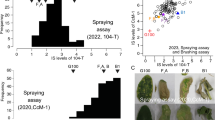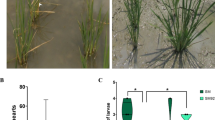Abstract
Fusarium wilt, Fusarium oxysporum f. sp. niveum (FON), of watermelon (Citrullus lanatus) is a fungal pathogen that causes significant yield losses in the US watermelon industry. FON damages watermelon through invasion of the root system and remains a difficult pathogen to manage due to its long-lasting survival spores which persist in the soil. Chemical control options for this pathogen are lacking, making development of genetic resistance the best option. There are four known races of FON (0, 1, 2, and 3) which are distinguished based on their pathogenicity of differential cultivars. Most modern cultivar releases have FON race 1 (FON-1) resistance, which has been mapped on the end of chromosome 1. Application of marker assisted selection (MAS) would improve the efficiency of FON-1 resistance breeding. In order to identify markers for selection in the FON-1 region, the QTL-seq method was utilized on an F2 population segregating for FON-1 resistance. Single nucleotide polymorphism (SNP) markers in the region were developed into Kompetitive allele-specific PCR (KASP™) assays and tested for trait association on the segregating F2:3 population. Marker validation was done using an F2 population from a cross between FON-1 susceptible “New Hampshire Midget” and FON-1-resistant “Calhoun Gray.” Further validation on a panel of susceptible and resistant cultivars and Plant Introductions identified SNP marker UGA1_502161 as a useful marker for selection of FON-1 resistance from Calhoun Gray.




Similar content being viewed by others
References
Armstrong GM, Armstrong JK (1978) Formae speciales and races of Fusarium oxysporum causing wilts of the Cucurbitaceae. Phytopathology 68:19–28
Brusca J, Zhang X (2012) Watermelon pollenizer SP-6. Google Patents
Correll JC (1991) The relationship between formae speciales, races, and vegetative compatibility groups in Fusarium oxysporum. Am Phytopathol Soc 81(9):1061–1064
Crall JM (1981a) Fifty years of watermelon breeding at ARC Leesburg. Florida Agricultural Experiment Stations Series 94:156–158
Crall JM (1981b) Sugarlee: an early, high quality, disease-resistant watermelon variety for Florida commercial growers. University of Florida Agricultural Experiment Station Series 277:1–5
Elmstrom GW, Hopkins DL (1981) Resistance of watermelon cultivars to fusarium wilt. Plant Dis 65(10):825–827. https://doi.org/10.1094/PD-65-825
Guo S, Zhang J, Sun H, Salse J, Lucas WJ, Zhang H, Zheng Y, Mao L, Ren Y, Wang Z, Min J, Guo X, Murat F, Ham BK, Zhang Z, Gao S, Huang M, Xu Y, Zhong S, Bombarely A, Mueller LA, Zhao H, He H, Zhang Y, Zhang Z, Huang S, Tan T, Pang E, Lin K, Hu Q, Kuang H, Ni P, Wang B, Liu J, Kou Q, Hou W, Zou X, Jiang J, Gong G, Klee K, Schoof H, Huang Y, Hu X, Dong S, Liang D, Wang J, Wu K, Xia Y, Zhao X, Zheng Z, Xing M, Liang X, Huang B, Lv T, Wang J, Yin Y, Yi H, Li R, Wu M, Levi A, Zhang X, Giovannoni JJ, Wang J, Li Y, Fei Z, Xu Y (2013) The draft genome of watermelon (Citrullus lanatus) and resequencing of 20 diverse accessions. Nat Genet 45(1):51–58. https://doi.org/10.1038/ng.2470
Hall CV (1963) Crimson sweet: a new disease resistant watermelon. Kansas Agricultural Experiment Station Series 347:1–3
Holdsworth WL, LaPlant KE, Bell DC, Jahn MM, Mazourek M (2016) Cultivar-based introgression mapping reveals wild species-derived Pm-0, the major powdery mildew resistance locus in squash. PLoS One 11(12):1–20. https://doi.org/10.1371/journal.pone.0167715
Houterman PM, Speijer D, Dekker HL, De Koster CG, Cornelissen BJ, Rep M (2007) The mixed xylem sap proteome of Fusarium oxysporum-infected tomato plants. Mol Plant Pathol 8(2):215–221. https://doi.org/10.1111/j.1364-3703.2007.00384.x
King Z, Serrano J, Boerma HR, Li Z (2014) Non-toxic and efficient DNA extractions for soybean leaf and seed chips for high-throughput and large-scale genotyping. Biotechnol 36:1875–1879. https://doi.org/10.1007/s10529-014-1548-8
Lambel S, Lanini B, Vivoda E, Fauve J, Wechter WP, Harris-Shultz KR, Massey L, Levi A (2014) A major QTL associated with Fusarium oxysporum race 1 resistance identified in genetic populations derived from closely related watermelon lines using selective genotyping and genotyping-by-sequencing for SNP discovery. Theor Appl Genet 127:2105–2115. https://doi.org/10.1007/s00122-014-2363-2
Li H, Durbin R (2009) Fast and accurate short read alignment with burrows-wheeler transform. Bioinformatics 25:1754–1760
Martyn RD (2014) Fusarium wilt of watermelon: 120 years of research. Hortic Rev 42:349–442
Martyn RD, Netzer D (1991) Resistance to races 0, 1, and 2 of fusarium wilt of watermelon in Citrullus sp. PI-296341-FR. Hortic Sci 26(4):429–432
Menda N, Strickler SR, Edwards JD, Bombarely A, Dunham DM, Martin GB, Meja L, Hutton SF, Havey MJ, Maxwell DP, Muellar LA (2014) Analysis of wild-species introgressions in tomato inbreds uncover ancestral origins. BMC Plant Biol 14(287):1–16
Meru G (2014) Genetic mapping of resistance to fusarium wilt and seed oil traits in watermelon. Dissertation, University of Georgia
Meru G, McGregor C (2016) Genotyping by sequencing for SNP discovery and genetic mappng of resistance to race 1 of Fusarium oxysporum in watermelon. Sci Hortic 209:31–40
Michelmore R (2000) Genomic approaches to plant disease resistance. Curr Opin Plant Biol 3(2):125–131
Milne I, Shaw P, Stephen G, Bayer M, Cardle L, Thomas WTB, Flavel AJ, Marshall D (2010) Flapjack—graphical genotype visualization. Bioinformatics 26(24):3133–3134
Niu X, Zhao X, Ling KS, Levi A, Sun Y, Fan M (2016) The FonSIX6 gene acts as an avirulence effector in the Fusarium oxysporum f. sp. niveum—watermelon pathosystem. Sci Rep 6:1–7. https://doi.org/10.1038/srep28146
Norton JD, Cosper RD, Smith DA, Rymal KS (1983) AU-Jubulent and AU-producer: quality, disease-resistant watermelon varieties for the south. Alabama Agricultural Experiment Station Series 280:1–12
Orton WA (1907) On methods of breeding for disease-resistance. Proc Soc Hortic Sci 5:1–31
Ren Y, Di J, Gong G, Zhang H, Guo S, Zhang J, Xu Y (2015) Genetic analysis and chromosome mapping of resistance to f. sp. (FON) race 1 and race 2 in watermelon (L.). Mol Breed 35(9):183. https://doi.org/10.1007/s11032-015-0375-5
Schmidt SM, Houterman PM, Schreiver I, Ma L, Amyotte S, Chellappan B, Boeren S, Takken FL, Rep M (2013) MITEs in the promoters of effector genes allow prediction of novel virulence genes in Fusarium oxysporum. BMC Genomics 14(119):119. https://doi.org/10.1186/1471-2164-14-119
Semagn K, Babu R, Hearne S, Olsen M (2013) Single nucleotide polymorphism genotyping using Kompetitive allele specific PCR (KASP): overview of the technology and its application in crop improvement. Mol Breed 33(1):1–14. https://doi.org/10.1007/s11032-013-9917-x
Shi Z, Bachleda N, Pham AT, Bilyeu K, Shannon G, Nguyen H, Li Z (2015) High-throughput and functional SNP detection assays for oleic and linolenic acids in soybean. Mol Breed 35(8). https://doi.org/10.1007/s11032-015-0368-4
Smith EF (1894) The watermelon disease of the south. Proc Am Assoc Adv Sci 43:289–290
Sun Y, Wang M, Li Y, Gu Z, Ling N, Shen Q, Guo S (2017) Wilted cucumber plants infected by Fusarium oxysporum f. sp. cucumerinum do not suffer from water shortage. Ann Bot 120(3):427–436. https://doi.org/10.1093/aob/mcx065
Takagi H, Abe A, Yoshida K, Kosugi S, Natsume S, Mitsuoka C, Uemura A, Utsushi H, Tamiru M, Takuno S, Innan H, Cano LM, Kamoun S, Terauchi R (2013) QTL-seq: rapid mapping of quantitative trait loci in rice by whole genome resequencing of DNA from two bulked populations. Plant J 74(1):174–183. https://doi.org/10.1111/tpj.12105
Tester M, Langridge P (2010) Breeding technologies to increase crop production in a changing world. Science 327:818–821
Untergasser A, Nijveen H, Rao X, Bisseling T, Geurts R, Leunissen JAM (2007) Primer3Plus, an enhanced web interface to Primer3. Nucleic Acids Res 35:71–74. https://doi.org/10.1093/nar/gkm306
van der Beek JG, Verkerk R, Zabel P, Lindhout P (1992) Mapping strategy for resistance genes in tomato based on RFLPs between cultivars: Cf9 (resistance to Cladosporium fulvum) on chromosome 1. Theor Appl Genet 84(1–2):106–112
Wehner TC (2008) Watermelon. In: Prohens J, Nuez F (eds) Vegetables I: Asteraceae, Brassicaceae, Chenopodicaceae, and Cucurbitaceae. Springer, New York, pp 381–418
Zhang X (2008) Watermelon pollenizer SP-4. Google Patents
Zhou XG, Everts KL, Bruton BD (2010) Race 3, a new and highly virulent race of Fusarium oxysporum f. sp. niveum causing fusarium wilt in watermelon. Plant Dis 94(1):92–98
Acknowledgments
This work was in part supported by the United States Department of Agriculture Specialty Crop Research Initiative Award No. 2014-51181-22471.
Author information
Authors and Affiliations
Corresponding author
Electronic supplementary material
ESM 1
(DOCX 96 kb)
Online Resource 1
(DOCX 32 kb)
Rights and permissions
About this article
Cite this article
Fall, L.A., Clevenger, J. & McGregor, C. Assay development and marker validation for marker assisted selection of Fusarium oxysporum f. sp. niveum race 1 in watermelon. Mol Breeding 38, 130 (2018). https://doi.org/10.1007/s11032-018-0890-2
Received:
Accepted:
Published:
DOI: https://doi.org/10.1007/s11032-018-0890-2




